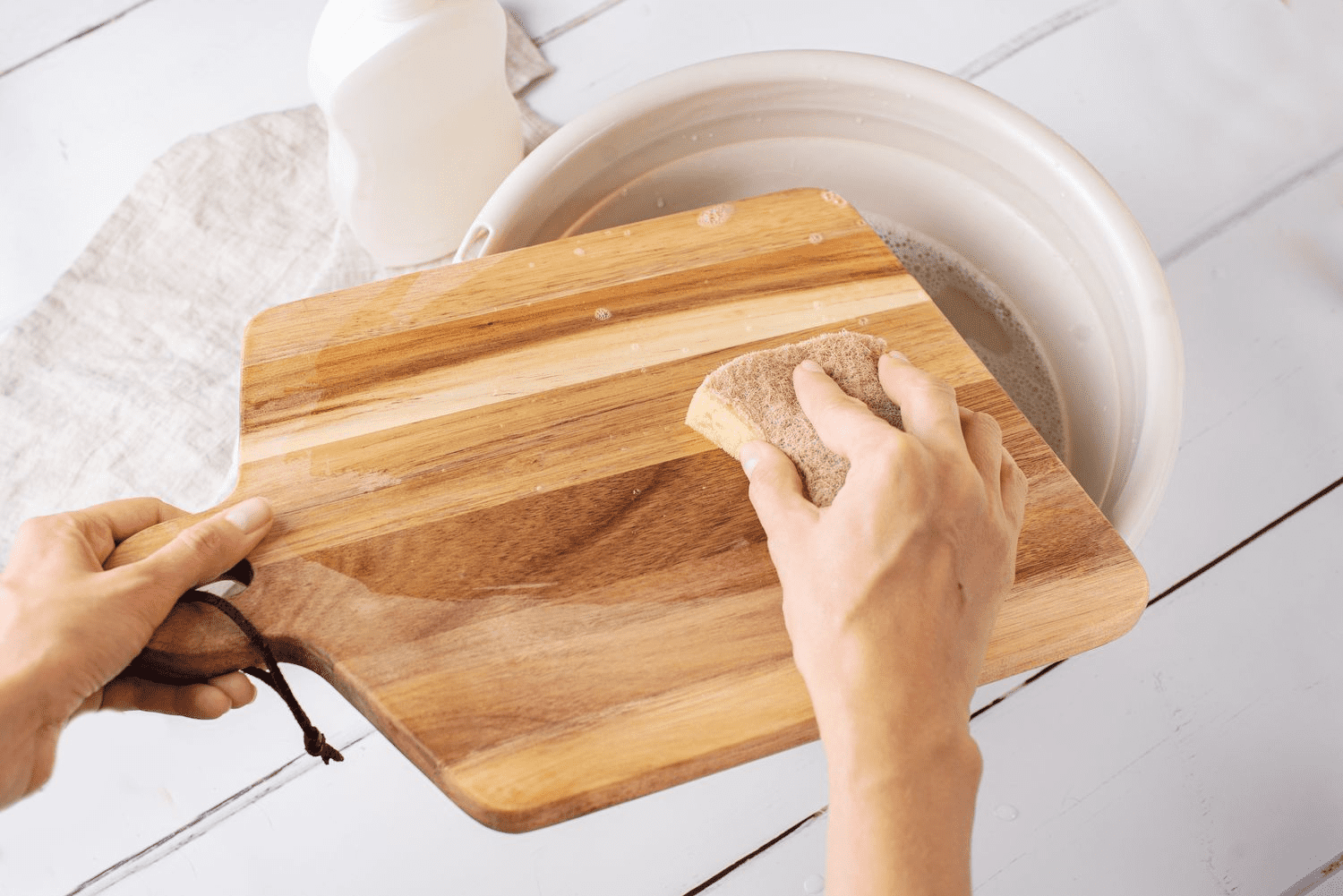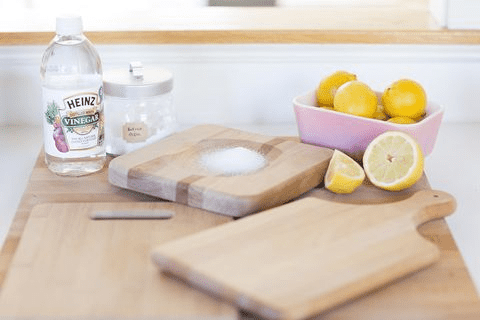Cooking can be stressful because of the cutting, seasoning, and other activities involved. You can be too tired to stand and wash the dishes used during and after the cooking process. However, if you want your wood-cutting board to spoil swiftly, try putting it into a dishwasher.
Wooden cutting boards are strong, sturdy, and can last multiple years, but they are incompatible with the dishwasher. It’s always better to clean the wooden cutting board yourself without the dishwasher.
This article will guide you on why you shouldn’t put your wooden cutting boards in the dishwasher. Here, I’ll explain the effects of placing the wood-cutting board in the dishwasher and other alternatives.
JUMP TO: Why You Cannot Put Wood Board in Dishwasher | How to Clean Wood Board | How to Sanitize Wood Board |
- Wooden cutting boards can warp and damage if you wash them with a dishwasher.
- Unlike plastic cutting boards, you can use the dishwasher to clean the wood cutting board once in a blue moon. If you must use the dishwasher, try to control the conditions.
- Washing wooden cutting boards manually is the safest way.
- Always air dry your wood cutting boards immediately after every wash.
Is It Safe to Put Wood Cutting Board In Dishwasher
A dishwasher is a great device to hold in your home, as you will save a lot of time. However, the machine uses a high level of moisture and heat, which isn’t safe for every type of material.
Wood, for instance, is a material that weakens with consistent exposure to too much water and high temperature. Hence, it will be affected when you consistently keep it in a dishwasher.
According to some experts, putting your wood-cutting boards in the dishwasher is safe if you don’t do it all the time. They also advise that the dishwasher is the best way to sanitize your wood-cutting board.
While I don’t wholly agree with these experts, I’m sure that wood reacts when exposed to harmful conditions over an extended period. So if you’re not consistently washing wood cutting boards in a dishwasher, you can seldom try it.
Most dishwashers have controls over the heat and hot water used. Hence, you can control it with a mild wash on the wood board. However, it is always better to use dishwasher-safe cutting boards.

Source: Wikipedia
CAUTION: Dry your wood board naturally immediately after washing it manually or with the dishwasher.
What happens when you consistently put your wooden cutting board into the dishwasher?
As much as possible, I’ll advise you not to put your wooden board into a dishwasher throughout your lifetime. Consistent use over a long period ensures that the cutting board will get some damage.
Some of the damages that consistent use of dishwashers can cause to your wooden kitchenware include the following;
Melting
The possibility of your wood cutting board melting is the scariest and most dangerous part of washing with a dishwasher. It is when the wood fibers dissolve into the water used to wash. Usually, this occurs when you consistently leave the cutting board wet in the dishwasher.
The best way to notice a melting wood cutting board is to find the wood color in the water used to wash it. Melting means you gradually lose parts of your wood-cutting boards daily. Also, whatever contaminants are in the wood cutting boards will spread to the other plates in the dishwasher.
Related Read: Acacia Vs. Teak Cutting Board – Here’s What To Buy!
Cracking
Crack signs on your wood-cutting board are good for getting another one. Cracks create holes where contaminants can survive; soon enough, you’ll start noticing mildew on your board.
Cracks occurring to your wood cutting boards depend on the dishwasher size. If the wood cutting board has an opportunity to lay flat and avoid high heat, the cracks may not surface.
Here’s how it works; when there is a crack, the water stays and fills the hole after every wash. Water breeds a suitable environment for contaminants, and cutting raw food will only hasten the process.
When you put wood boards in a dishwasher, the water and heat can cause cracks, rendering your board useless. You can prevent cracks by washing them manually.
Note: If you notice any cracks on your wood-cutting board, it is time to replace it. Some cutting boards come with the “dishwasher safe” symbol, indicating that its design stops the effects of such heat from the dishwasher.
Warping
Cutting boards are critical kitchen devices because they are flat and solid, making cutting easy. If these boards lose their ability to remain flat on a surface, you will struggle whenever you want to cut. Warping is a situation when your board loses its shape due to high temperatures.
Washing your wood cutting boards consistently in a dishwasher is usually the base course of warping. The heat and water in the device will cause shrinkage, bends, and cracks. Usually, the part of the board exposed to more heat and water is the first to start warping.
When a wood-cutting board warps, you’ll have to hold the board before you can cut. If you’re cutting items that you require to hold firmly, it becomes more difficult. In some cases, a warped cutting board may cause serious injuries to your board when you are cutting.
Tips: If you have plans to change your wood cutting board regularly for safety reasons, you can wash it in a dishwasher. However, don’t forget to change it after two years at most.
How to Clean A Wood Cutting Board
Cleaning a wood cutting board is not complex; you only need the right compounds and tools. However, cleaning a cutting board is one of the important steps required to maintain your cutting board. Hence, you have to clean the cutting board right.
It’s better to wash it with your hands using soap and water. Bleach and acids may seem like a good idea to make it clean, but it usually endangers your health.
Here is the process of cleaning a wood-cutting board;
- Remove all food items from the surface of the board. Raw items may not come off quickly if you wash them with soap, a sponge, and water. A bench scraper is better for removing these sticky items from the roots.
- You can use a hydrogen peroxide solution on the board’s surface if you have cut raw food like fish or meat.
- After removing the sticky food items, you can wash your board thoroughly with soap and water. Remember to use a sponge to scrub the face of your cutting board well. That’s the only way the dirt will clear.
- Rinse the soap and other contaminants out of the board with clean water. Water is very crucial to the success of the washing process, so you must use enough water to clean the surface.
- After cleaning the board with soap and plenty of water, ensure it is dry before your subsequent use. Ensure you dry it naturally without heat.
TIPS: If you want to keep your food safe, rinse with lots of water.

Source: The Spruce
How to Sanitize A Cutting Board
People get tempted to put their wood-cutting boards in a dishwasher to sanitize them. Over an extended period of using the cutting board, it is critical to sanitize the board better. Sanitizing the board means you are cleaning it deeper than regular cleaning.
There are ways to sanitize your board manually without using a dishwasher washer. You can use vinegar and water or a lemon and salt mix. EPA does not recognize vinegar as a sanitary material, but it does the job.
Also Read: Can Cutting Boards Dull Knives? [Answered]
If you’re using vinegar, here’s how to sanitize the cutting board;
- Wash, clean, and dry the board’s surface, as described above.
- Mix your solution of vinegar and water in a spray bottle if possible. The water content should be at least three times more than the vinegar content.
- Spray the solution on the surface of your cutting board and wait for a while. You are waiting for the vinegar to do its work after spraying.
- Rinse, wash, and rinse the board after the process. Vinegar may leave its taste on your board’s surface, so it is better to rewash it. Remember to rinse the vinegar off first before washing.
If you’re using lemon and salt, there are two ways to do it. You either pour salt on the surface you want to sanitize or scrub it with lemon. Or you cut the lemon into small bits, mixed with salt, and use it to clean the surface.

Source: The Pioneer Woman
Bottomline
Washing your wood-cutting board in the dishwasher may seem like a good idea when you feel stressed. However, if you want to use the wood-cutting board for a long time, you should avoid the dishwasher.
Wash and clean the cutting board thoroughly and manually if you want to clean a cutting board, and try to avoid dishwashers.
![Wood Cutting Board Vs. Plastic Board [Which is Safer?] Wood Cutting Board Vs. Plastic Board [Which is Safer?]](https://houseadorable.com/wp-content/uploads/2023/01/wood-board.jpg)
![27 Types of Cutting Boards Explained [Buying Guide Included] 27 Types of Cutting Boards Explained [Buying Guide Included]](https://houseadorable.com/wp-content/uploads/2022/12/cutting-board.jpg)
![How to Season A Cutting Board? [Simple Steps Explained] How to Season A Cutting Board? [Simple Steps Explained]](https://houseadorable.com/wp-content/uploads/2022/12/cutting.jpeg)
![Charcuterie Board Vs. Cutting Board [8 Differences] Charcuterie Board Vs. Cutting Board [8 Differences]](https://houseadorable.com/wp-content/uploads/2023/01/316322082_5650827684977137_862859335334204275_n.jpg)
![Bamboo Vs. Wood Cutting Board [9 Differences Explained] Bamboo Vs. Wood Cutting Board [9 Differences Explained]](https://houseadorable.com/wp-content/uploads/2023/01/cutting-board.jpg)
![Is Acacia Wood Good For Cutting Boards? [Explained] Is Acacia Wood Good For Cutting Boards? [Explained]](https://houseadorable.com/wp-content/uploads/2023/01/wood-table-top-with-acacia-chopping-board-with-blur-kitchen-counter-background-is.jpg)
![Granite Vs. Marble Vs. Quartz Countertops [12 Differences+Pros & Cons] Granite Vs. Marble Vs. Quartz Countertops [12 Differences+Pros & Cons]](https://houseadorable.com/wp-content/uploads/2022/03/quartz-marble.jpg)
![Is Mold on Cutting Board Dangerous? [Explained in Detail] Is Mold on Cutting Board Dangerous? [Explained in Detail]](https://houseadorable.com/wp-content/uploads/2023/01/image.jpg)